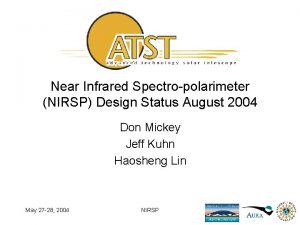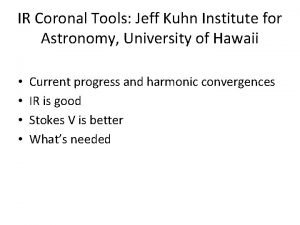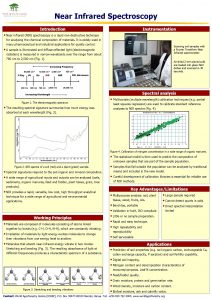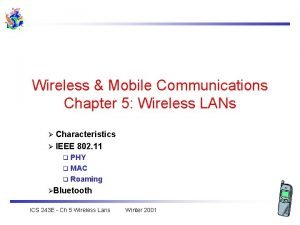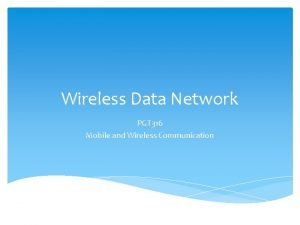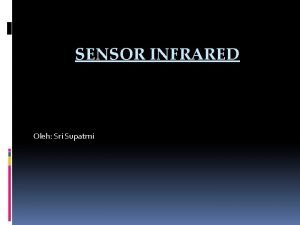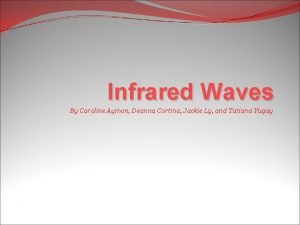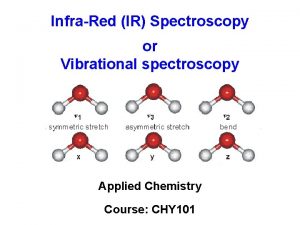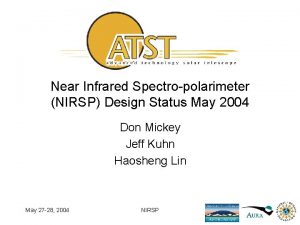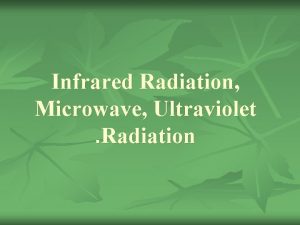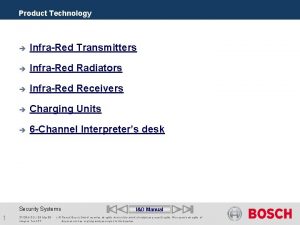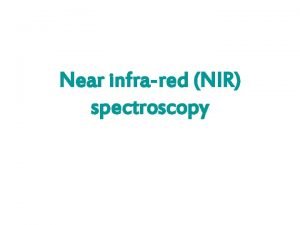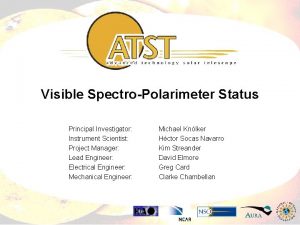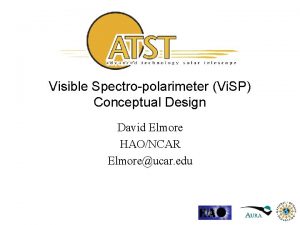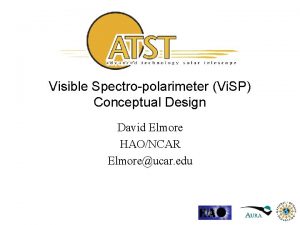Near Infrared Spectropolarimeter NIRSP Design Status May 2004











- Slides: 11

Near Infrared Spectro-polarimeter (NIRSP) Design Status May 2004 Don Mickey Jeff Kuhn Haosheng Lin May 27 -28, 2004 NIRSP

NIRSP Modules • Two spectrograph modules, one on coudé platform and the other at Nasmyth. • Common basic design; common camera. • Coudé: high spatial resolution, multi-camera capable. Warm optics on optical bench. AO observations of limited field. • Nasmyth: Coronal observations and wide-field disk observations. Cold optics. May 27 -28, 2004 NIRSP 2

NIRSP Requirements Specification Requirement Wavelength Range 900– 5000 nm 1 Spectral Resolution 50, 000– 300, 000 1 Transmission 30% 1 Modulation efficiency 90% of max attainable 1 Polarimetric accuracy 10 -4 Ic 5 10 -5 1 Spatial Resolution 0. 05 arc sec / pixel 0. 025 arc sec / pixel 1 Spatial Field 3 arc min at 0. 1 arc sec 5 arc min at 0. 1 arc sec 1 Spatial Scanning Slit, step 0. 05 arc sec Slit, step 0. 025 arc sec 1 Wavelength Diversity 3 simultaneous 5 simultaneous 2 Obs with Vi. SP Flexible setup May 27 -28, 2004 NIRSP Goal Priority 1 3

NIRSP Coudé Unit • Feed at f: 40 – Spatial scale 0. 776 mm / arc sec • Field lens near entrance slit (if required) – Makes beam telecentric • Slit nominal 36 µm – Spatial sampling 0. 046 arc sec • Grating is R 2 (tan = 2) echelle – Angular dispersion 4/ µrad/pm (near-Littrow) • Reflective Littrow layout, off-axis parabola – Coma-corrected at any grating angle – Minimal astigmatism – Spectrograph magnification = 1. 0 May 27 -28, 2004 NIRSP 4

NIRSP Coudé, more • Collimator focal length 2. 25 m – Geometric pupil diameter 56 mm – Linear dispersion 5. 75 µm/pm at = 1. 565 µm • Grating width 300 mm (projected width 135 mm) – Diffraction image width at focal plane is 26 µm – Slit diffraction overfills grating; 12% light loss at = 1. 565 – Ruling frequency 87 mm-1, or TBD • Detector like Hawaii-2 RG, 1 2 mosaic – – – 18 µm pixels, bin 2 2 Field 95 arc sec Spectral sampling 6. 3 pm Resolving power 200, 000 at = 1. 565 Increase f to 3 m and w to 400 mm gives R=270, 000 May 27 -28, 2004 NIRSP 5

Multiple Slits At Coudé, the FPA width covers 6. 4 nm at 1. 565. The optical quality is good over the entire field, so we might think of using a narrow-band blocker and up to six slits. May 27 -28, 2004 NIRSP 6

NIRSP Nasmyth • Feed at f: 13. 08 (same as Gregorian image) – Spatial scale 0. 254 mm / arc sec • Field lens near entrance slit – Makes beam telecentric • Slit nominal 108 µm for coronal observations, 18 µm for disk observations – Spatial sampling 0. 425 arc sec to 0. 07 arc sec • Grating is R 2 (tan = 2) echelle – Angular dispersion 4/ µrad/pm (near-Littrow) • Reflective Littrow layout, off-axis parabola – Coma-corrected at any grating angle – Minimal astigmatism – Spectrograph magnification = 1. 0 May 27 -28, 2004 NIRSP 7

NIRSP Nasmyth, more • Collimator focal length 1. 3 m – Geometric pupil diameter 99 mm – Linear dispersion 3. 32 µm/pm at = 1. 565 µm • Grating width 300 mm (projected width 135 mm) – Diffraction image width at focal plane is 15 µm – Slit diffraction overfills grating; 20% light loss at = 1. 565 with 18 µm slit (3% loss with 108 µm slit) – Ruling frequency 87 mm-1, or TBD • Detector like Hawaii-2 RG, 1 2 mosaic – – 18 µm pixels, bin 6 6 (or more!) for corona Field 290 arc sec Spectral sampling 5. 4 pm photosphere; 22 pm corona 1. 07 µm Resolving power 225, 000 at = 1. 565 May 27 -28, 2004 NIRSP 8

Nasmyth Scanning • How do we scan the image at Nasmyth? – Scan the telescope? – Scan the spectrograph? – Add a scanning mirror to the relay optics? May 27 -28, 2004 NIRSP 9

Tip-tilt at Nasmyth • Nasmyth observations need tip-tilt correction • T-T options – Active secondary – Active second relay mirror • Image moves 2. 5 mm for 10 arc sec; pupil moves 1. 2 mm. – Add a pupil mirror to the relay optics May 27 -28, 2004 NIRSP 10

Nasmyth Context Image • • How do we get a context image? Multiple slits make slit viewer “difficult. ” Dichroic or bandpass ahead of slit? Infrared, or visible, context image? May 27 -28, 2004 NIRSP 11
 Nirsp
Nirsp Nirsp login
Nirsp login Nir spectroscopy instrumentation
Nir spectroscopy instrumentation Near hip near shoulder tackling
Near hip near shoulder tackling Infrared vs bluetooth
Infrared vs bluetooth Infrared vs bluetooth
Infrared vs bluetooth Pengertian sensor infrared
Pengertian sensor infrared Bill nye reflection and refraction
Bill nye reflection and refraction Characteristic of infrared waves
Characteristic of infrared waves Infrared spektroskopisi
Infrared spektroskopisi Anharmonicity constant formula
Anharmonicity constant formula A food handler is reheating commercially processed cheese
A food handler is reheating commercially processed cheese
